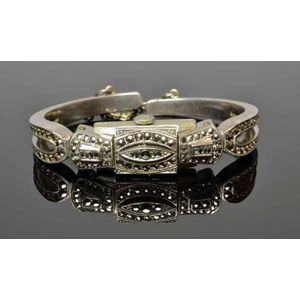Art Deco Rotary Bracelet Watch with Marcasite
You must be a subscriber, and be logged in to view price and dealer details.
Subscribe Now to view actual auction price for this item
When you subscribe, you have the option of setting the currency in which to display prices to $Au, $US, $NZ or Stg.
- Art Deco Period - The Art Deco period was a cultural movement that emerged in the 1920s and 1930s, and was characterized by its emphasis on modernism, luxury, and elegance. The name "Art Deco" comes from the Exposition Internationale des Arts Décoratifs et Industriels Modernes, a large exhibition held in Paris in 1925 that showcased the latest trends in decorative arts.
Art Deco was a reaction against the ornate and elaborate styles of the previous era, and reflected a new modern sensibility. It was characterized by streamlined, geometric shapes, bright colours, and the use of new materials such as chrome, glass, and Bakelite. Art Deco designers sought to create a sense of luxury and sophistication, often incorporating expensive materials such as ivory, marble, and rare woods.
Art Deco had a significant impact on a wide range of artistic fields, including architecture, fashion, graphic design, and interior design. Some of the most iconic examples of Art Deco architecture include the Empire State Building in New York City, the Hoover Building in London, and the Palais de Chaillot in Paris.
The Art Deco period came to an end in the 1940s, as World War II and changing cultural trends led to a shift in artistic styles. However, Art Deco remains an important influence on design and art, and continues to be celebrated for its modernist sensibility and glamorous aesthetic. - Movement - The technical name for the workings of a clock or watch, and does not include the dial or case.
- Marcasite - Marcasite is a mineral, iron sulphide, but is rarely used in jewellery. Instead marcasite is the name given to iron pyrites, the mineral sold as marcasite which is identical in copmosition to iron sulphide but crystalises as a cube, making it more suitable for jewellery. It is a brassy yellow in colour and is also known as "fool's gold", and sits well with silver rather than gold becasue of its colour.
Marcasite has been used in jewellery since ancient times and became popular again in jewellery in the 18th century, continuing through to the early 20th century, with the settings becoming cheaper as time progressed, eventually earning the sobriquet "costume jewellery" along with other cheap jewellery that was made for a prevailing pattern and meant to be changed with each new outfit.
This item has been included into following indexes:
Visually similar items

18ct yellow gold diamond ring featuring centre round brilliant cut, bezel set, 0.92ct in weight, PI in clarity and G in colour 18 round brilliant cut diamonds, claw set, 0.23ct in total combined weight, SI clarity and G in colour, size 'O/P'

9ct yellow gold Victorian bangle, having a central garnet topped doublet with four surrounding diamonds on a circular mount and decorated with gold wire twist and floral motifs. Diameter 6.8 cm with safety chain

Diamond dress ring 0.41ct Cognac diamond clarity VS, surrounded by 10 x round diamonds of G colour, SI clarity, being channel set Paul Bradly maker handmade in 18ct yellow gold size M 6.6 grams

Bejewelled silver turtle pill box, 9.5 cm long
